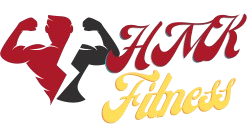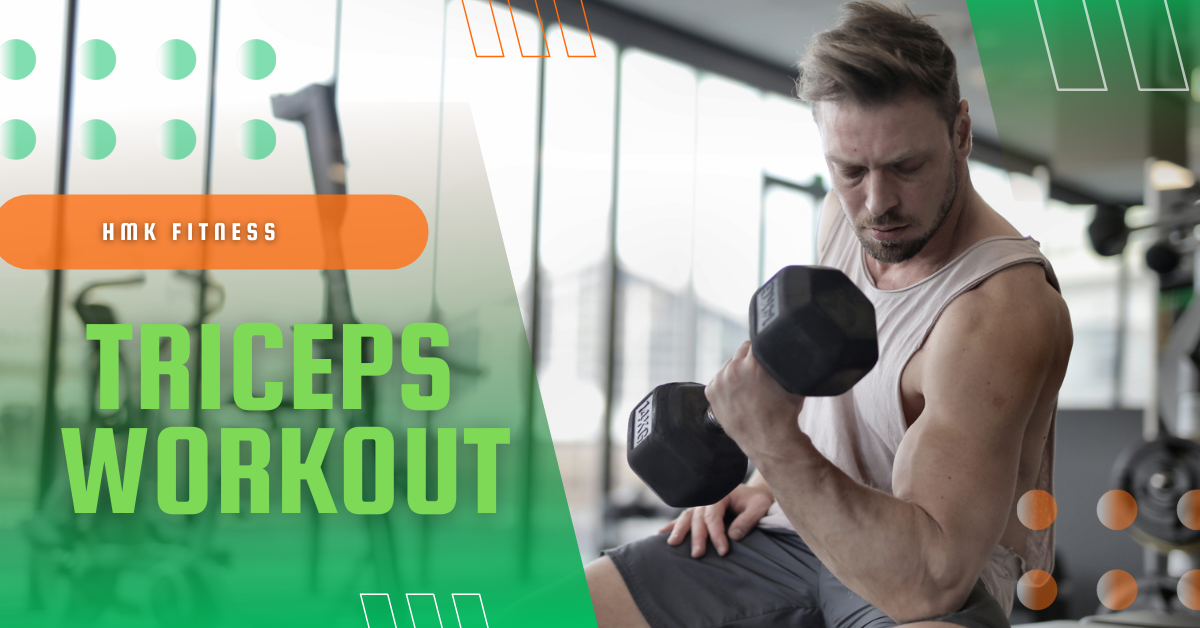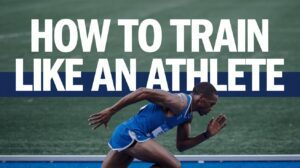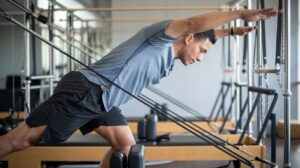Table of Contents
ToggleIntroduction:
When building impressive arms, the triceps play a crucial role. While many focus on the biceps for arm size, the triceps make up about two-thirds of the upper arm’s muscle mass. Among the three heads of the triceps, the long head, lateral head, and medial head, the long head is particularly important for achieving that full, horseshoe-shaped look that many fitness enthusiasts strive for.
The long triceps head is vital not only for aesthetics but also for functional strength. It contributes significantly to upper arm development and is key in various pushing movements. This blog will delve into the best exercises to effectively target the triceps long head, ensuring you get the most out of your arm workouts.
Understanding The Anatomy Of The Triceps:
To effectively target the triceps long head, it’s necessary to understand the anatomy of the triceps muscle group. As the name suggests, the triceps consist of three heads: the long head, lateral head, and medial head. Each of these heads plays a unique role in extending the elbow and contributing to overall arm strength.
The long head of the triceps is the largest of the three and attaches to the scapula, making it distinct from the lateral and medial heads, which attach to the humerus. This anatomical connection allows the long head to assist in shoulder extension and stability, in addition to its primary role in elbow extension.
Focusing on the long head contributes to building bigger, more defined arms and enhances shoulder stability, which is crucial for exercises like bench presses and overhead movements. Understanding this anatomy helps you target the long head more effectively in your workouts, ensuring balanced arm development and improved strength.
Importance of Targeting the Triceps Long Head:
Focusing on the tricep’s long head is crucial for building well-rounded, strong arms and brings significant aesthetic benefits. While all three heads of the triceps contribute to arm size, the long head is particularly important for creating that thick, full appearance often associated with impressive upper arm development. This should excite you about the potential for your arm’s appearance.
One of the primary benefits of targeting the triceps long head is the balanced arm growth it promotes. Many lifters must pay more attention to the lateral head, leading to disproportionate arm development. Including exercises that specifically engage the long head ensures that your triceps grow uniformly, resulting in a more aesthetically pleasing look.
Moreover, the long triceps head plays a significant role in improving your strength in pressing movements. Since it connects to the scapula, it contributes to both elbow extension and shoulder extension, making it a key muscle group for exercises like the bench press, overhead press, and dips. Strengthening the long head can significantly improve your performance in these compound lifts, leading to overall strength gains and boosting your confidence in your training.
Top Triceps Long Head Exercises:
Targeting the triceps long head effectively requires specific exercises that engage this part of the muscle. Below are some of the best exercises you can incorporate into your routine to maximize the development of the triceps long head.
Overhead Triceps Extension:
The overhead triceps extension is one of the most effective exercises for isolating the triceps long head. This exercise places the triceps in a stretched position, ideal for activating the long head.
How to Perform:
- Stand or sit with a dumbbell or EZ bar held overhead.
- Keep your elbows close to your head and lower the weight behind your head by bending your elbows.
- Extend your arms to lift the weight back to the starting position.
Variations:
Use a single or two dumbbells to focus more intensely on each arm.
Cables can be used for constant tension throughout the movement.
Tips:
⦁ Keep your core tight and avoid flaring your elbows outward.
⦁ Focus on a slow and controlled movement to maximize muscle engagement.
Close-Grip Bench Press:
The close-grip bench press is a compound movement that primarily targets the triceps, strongly emphasizing the long head.
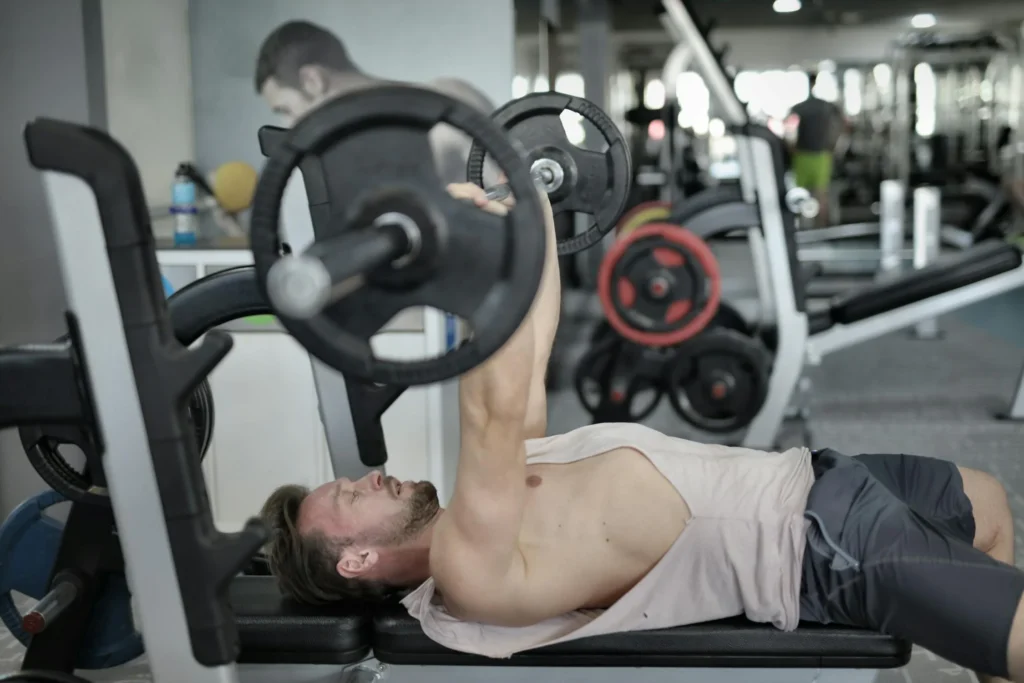
How to Perform:
Lie on a bench with your hands placed closer than shoulder-width apart on the barbell.
Lower the barbell to your chest, keeping your elbows close to your body.
Push the barbell back up to the starting position, focusing on using your triceps.
Adjustments:
Ensure your grip is close enough to emphasize the triceps but not so close that it causes discomfort in your wrists.
Use a slight decline bench to shift more emphasis onto the triceps.
Common Mistakes:
Avoid flaring your elbows too much, reducing triceps activation and placing undue stress on the shoulders.
Skull Crushers (Lying Triceps Extensions):
Skull crushers, also known as lying triceps extensions, are excellent for isolating the long triceps head. The angle of this exercise ensures a deep stretch in the long head.
How to Perform:
Lie on a flat bench with an EZ bar or dumbbell above your chest.
Lower the weight towards your forehead by bending your elbows.
Extend your arms to lift the weight back to the starting position.
Variations:
Use a decline bench to increase the stretch on the long head.
Experiment with different grips (narrow or wide) to see which engages your triceps the most.
Safety Tips:
Keep the movement controlled to prevent elbow strain.
Avoid locking out your elbows at the top of the movement to maintain tension on the triceps.
Creating an Effective Triceps Long Head Workout Routine:
To maximize the growth and strength of your triceps long head, it’s essential to structure your workout routine effectively. A well-designed routine targets the long head and ensures balanced development of the entire triceps muscle group.


Sample Workout Routine:
Here’s a sample workout routine focusing on the long triceps head while engaging the lateral and medial heads for overall arm development.
Warm-Up:
⦁ 5-10 minutes of light cardio to increase blood flow.
⦁ Dynamic stretches focusing on the shoulders and triceps.
Workout:
- Overhead Triceps Extension – 3 sets of 10-12 reps
⦁ Focus on a full range of motion and controlled movement to fully engage the long head. - Close-Grip Bench Press – 4 sets of 8-10 reps
⦁ This compound movement will target the long head while engaging the chest and shoulders. - Skull Crushers – 3 sets of 10-12 reps
⦁ Perform this exercise with a controlled motion to prevent elbow strain and maximize muscle engagement. - Rope Triceps Pushdown – 3 sets of 12-15 reps
⦁ Use a rope attachment to allow for a greater range of motion and focus on the contraction at the bottom of the movement. - Dumbbell Kickbacks – 3 sets of 12-15 reps
⦁ Perform this exercise with a lightweight weight to ensure controlled movement and full extension of the triceps.
Balancing Volume and Intensity:
To continue seeing gains in triceps size and strength, you must apply the principle of progressive overload. This means gradually increasing the weight, reps or sets over time to challenge your muscles continually.
Tips for Progressive Overload:
Increase the weight by small increments once you can complete the upper end of your rep range with good form.
Add an extra set or a few more reps to your routine as you build endurance and strength.
Focus on improving your form and mind-muscle connection before increasing your weight.
Incorporating Into Your Existing Workout Plan.
If you already have a workout routine, these triceps long-head exercises can be integrated into your upper body or on push days. Ensure that you’re giving your triceps adequate recovery time between workouts, typically 48-72 hours, depending on the intensity of your sessions.
Common Mistakes to Avoid When Training the Triceps Long Head:
When training the triceps long head, it’s crucial to avoid common mistakes that can hinder your progress or even lead to injury. By understanding and correcting these errors, you can ensure that your workouts are safe and effective.
- Neglecting the Mind-Muscle Connection:
One of the most common mistakes in triceps training is failing to engage the mind-muscle connection. Going through the motions without focusing on your target muscle can produce suboptimal results.
Solution:
Slow down your repetitions and focus on feeling the triceps long head working during each exercise.
Visualize the muscle contracting and stretching with each movement. - Using Too Much Weight:
While lifting heavy is important for muscle growth, using excessive weight can compromise your form and reduce the effectiveness of the exercise, especially when targeting the triceps long head.
Solution: - Choose a weight that allows you to perform each exercise with proper form.
Focus on controlled movements rather than lifting as much weight as possible. - Overemphasizing the Lateral Head:
Many lifters unknowingly place too much emphasis on the lateral head of the triceps, neglecting the long head. This can lead to imbalanced arm development and missed growth opportunities.
Solution: - Incorporate exercises targeting the triceps long head, such as overhead extensions and skull crushers.
Ensure your workout routine is balanced to engage all three heads of the triceps. - Flaring the Elbows During Pressing Movements.
When performing pressing movements like the close-grip bench press, flaring the elbows out can shift the emphasis away from the triceps and onto the shoulders, reducing the effectiveness of the exercise for the long head.
Solution:- Keep your elbows close to your body during pressing movements.
Focus on keeping a narrow grip and proper form to target the triceps effectively. - Neglecting Proper Warm-Up:
Jumping into heavy triceps exercises without a proper warm-up can increase the risk of injury, particularly in the elbows and shoulders.
Solution:
Start your workout with a thorough warm-up, including light cardio and dynamic stretches for the upper body.
Before moving on to your working sets, perform a few warm-up sets with lighter weights.
By avoiding these common mistakes, you can enhance the effectiveness of your triceps workouts and make significant progress in developing the long head of your triceps.
Tips for Maximizing Results:
To achieve the best results in developing your triceps long head, it’s essential to go beyond just exercise selection. Here are some key tips to help you maximize your gains and ensure that your hard work translates into noticeable improvements.
To achieve the best results in developing your triceps long head, it’s essential to go beyond just exercise selection. Here are some key tips to help you maximize your gains and ensure that your hard work translates into noticeable improvements.


- Prioritize Proper Nutrition:
Nutrition plays a critical role in muscle growth and recovery. To build a well-defined triceps long head, ensure you’re fueling your body with the right nutrients.
Protein Intake: Aim for 1.2 to 2.2 grams of protein per kilogram of body weight daily to support muscle repair and growth.
Balanced Diet: Include a variety of whole foods, such as lean meats, fish, eggs, vegetables, and whole grains, to give your body the vitamins and minerals needed for optimal performance.
Hydration: Stay hydrated throughout the day, as dehydration can negatively affect muscle function and recovery. - Focus on Recovery:
Recovery is just as important as your workout routine. Your muscles won’t have the necessary time to repair and grow without adequate recovery.
Rest Days: Incorporate at least one to two rest days weekly to allow your triceps to recover fully.
Sleep: Aim for 7-9 hours of quality sleep each night, as this is when your body repairs and builds muscle tissue.
Stretching and Mobility: Include stretching and mobility exercises in your routine to improve flexibility and reduce the risk of injury. - Incorporate Stretching and Mobility Work:
Flexibility and mobility are often overlooked aspects of training that can significantly impact your triceps development.
Post-Workout Stretching: After your triceps workout, spend 5-10 minutes stretching the triceps and shoulder muscles to enhance flexibility.
Mobility Drills: Include shoulder and elbow mobility drills in your warm-up routine to ensure your joints are primed for exercise. - Monitor Progress and Adjust:
Consistently track your progress to ensure you’re moving toward your goals. Adjust your routine as needed to continue making gains.
Progressive Overload: Continuously challenge your triceps by gradually increasing your workout’s weight, reps, or sets.
Regular Assessments: Regularly measure your arm size and strength levels to track your progress.
Routine Adjustments: If progress stalls, consider changing up your exercises, rep schemes, or rest periods to keep your muscles challenged.
Mind-Muscle Connection:
Maximizing the engagement of the triceps long head requires a strong mind-muscle connection. This means focusing on the muscle you work on during each rep and ensuring it is fully engaged.
Concentration: During each exercise, concentrate on the long head of your triceps, visualizing it contracting and extending.
Controlled Movements: Use slow and controlled movements to ensure that the triceps long head is fully activated throughout the range of motion.
Conclusion:
Developing the triceps long head is essential for building stronger, more defined arms. By incorporating targeted exercises like overhead triceps extensions, close-grip bench presses, and skull crushers into your workout routine, you can ensure that this often-overlooked muscle gets the attention it deserves.
Remember, balanced arm development requires more than just exercise—it demands proper nutrition, consistent recovery, and a focus on the mind-muscle connection. By avoiding common mistakes and following the tips outlined in this blog, you’ll be well on your way to achieving impressive triceps growth and overall upper-body strength.
Now that you have the knowledge and tools to train the triceps long head effectively, it’s time to put them into practice. Start integrating these exercises into your routine, monitor your progress, and watch as your arms transform. Remember to share your results and experiences with others on the same journey.
FAQs:
What is the best exercise for the triceps long head?
The best exercise for the long triceps head is often considered the overhead triceps extension. This exercise places the long head in a stretched position, crucial for maximizing its activation and promoting growth.
How often should I train the triceps long head?
Training the triceps, including the long head, is generally recommended 2-3 times weekly. This frequency allows for adequate stimulus while providing enough recovery time between sessions. Ensure you’re not overtraining by giving your muscles at least 48 hours of rest between targeted triceps workouts.
Can I train the triceps long head without equipment?
You can train the triceps long head without equipment using bodyweight exercises like diamond push-ups or triceps dips. While these exercises may not isolate the long head as effectively as those performed with weights, they still offer a solid workout option.
What are the signs of good triceps long-head activation?
Good triceps long-head activation is typically felt as a deep burn or muscle engagement along the back of the upper arm, particularly during exercises like overhead extensions and close-grip bench presses. If you’re feeling the muscle working and completing the last few reps is challenging, you’re likely activating it well.
How can I avoid elbow pain when training the triceps long head?
Focus on using proper form and controlled movements.
Avoid locking out your elbows at the top of exercises, and ensure you’re warming up adequately before starting your workout.
If you experience persistent pain, consider lowering the weight or consulting with a fitness professional.
